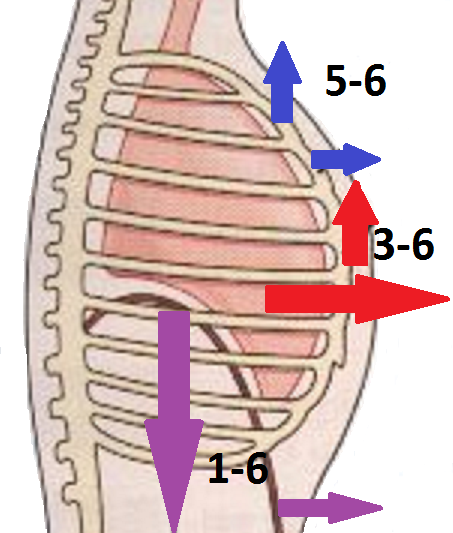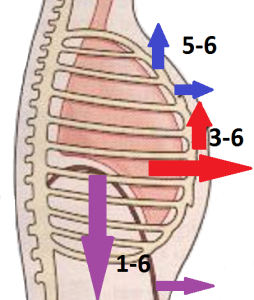The complete breath is a more advanced technique based on deep breathing and should not be attempted until you are comfortable with the deep breathing practise. I first learned this practise at T’ai Chi classes where it was called 3 compartment breathing and later discovered the overlap with yogic breathing.
The complete breath is another tool for relaxation and taking control of your autonomic nervous system. Like deep breathing, once learned it can be employed at times of stress or anxiety and should help prevent your sympathetic nervous activity from going wild. Practised regularly it could aid sleep and help boost immune function. This technique is a precursor to rhythmic breathing, the breathing practise best employed during self-healing visualisations.
- Start by sitting or lying in a comfortable position but with the spine as straight as possible. If you are lying you may want to put a cushion under your knees. If sitting try to imagine being suspended by an invisible chord at your crown, so that your spine is tall and extended and everything else is just loosely hanging from it. Your chin should feel very slightly tucked down
- Place your bottom hand so that the little finger is on the belly button , thumb more or less above the sternum. Place the top hand on your chest, little finger above the sternum, thumb near the collar bone. Start slowly breathing into your abdomen, as you learned with deep breathing.
- Then gently expand your rib cage (so that your bottom hand is moved). You will now be filling both the bottom and the middle parts of your lungs. The idea is that you continue filling the bottom part at the same time as filling the middle part.
- Once you feel comfortable with this, the next stage will be to allow your chest to rise towards your chin, expanding it slightly at the same time. You will then be filling the upper part of your lungs as well.
- Once you are comfortable with filling these three areas of your lungs you can introduce timing. Count to 6 slowly as you inhale. On the first 2 counts focus on breathing into the bottom part of your lungs. On the next 2 introduce the mid breathing whilst continuing the lower breathing. On the final 2 introduce the upper breathing, continuing with the lower and the mid.
- As you exhale very gently let go of all muscular effort. As the air escapes, your chest, ribs and abdomen will gently sink in on themselves.
Remember to take your time to learn this technique, practising just a little every day. Never force it or exert yourself. Your breathing muscles can tire just as easily as any other muscle if you push it, which could leave you in pain for days. (I’ve been there – learn from my mistake!)
The collecting mental energy visualisation aims to help you settle down if you are finding it particularly difficult to calm your thoughts during meditation. Equally it can be used at any other time you are having difficulties with racing thoughts.
- First imagine your busy thoughts as forms of energy. In reality thoughts are made up from electrical energy flowing through the nerves in your brain, like currant flows through a wire.
- Now imagine this energy as a liquid, perhaps you can replace the image of currant flowing through a wire with that of liquid flowing through a pipe.
- Now imagine all this chaotic thought energy all flowing in one direction towards a lake that sits behind the centre of you eyebrows, from this lake there is a water fall that takes the energy down to your gut, your central energy reserve.
- With each in breath more of your frantic thought energy flows towards the lake and with each out breath it continues over the waterfall cascading down into you central store, which sits deep and calm below.
After a few minutes of this visualisation you might want to return to the meditation practise that was eluding you. Or you may just feel clearer headed and better able to think or make a decision.
I thank Yair Sagy for teaching me this visualisation






